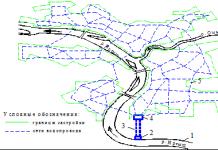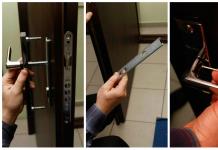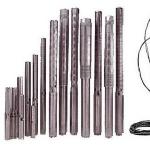Almost all units of this type can be divided into two main groups used for dirty or clean water, although there are many more subspecies. So, in order to understand how, for example, a pump for a well of 10 meters differs from a device that is used for a well of the same depth, we will pay attention to the classification by purpose. We will talk about all this, as well as editing, below, and in addition, we will watch the thematic video in this article as additional material.
About submersible pumps
Purpose

- The implementation of water intake from water sources of this type can be carried out both by a surface (hydrophore) and a submersible unit for pumping water. But the pump for a well of 15 meters will already be of a submersible type, since hydrophores are only effective up to 9 meters in depth (meaning the level of water rise). Such devices have an elongated cylindrical shape with a small cross section to make it more convenient to place them in the production pipe, and have a cable attached to the body for fixing on the surface.
- Such units, as a rule, are centrifugal and are designed exclusively for clean water (without large impurities such as sand or silt). This pump for a well of 80 meters or even 200-250m can perfectly meet the needs of not only domestic, but also industrial. In order to avoid interruptions in water supply, the power of the unit is selected according to the amount of water consumed, and you can see such calculations for the house in the table below.
Water consumption per hour by different bathrooms
- Outwardly, a vortex pump for a well of 40 meters or more is very similar in appearance to a centrifugal unit, only the water supply here is carried out in a slightly different way. Such devices are used when it is necessary to create a strong pressure with a small volume of water, for example, for washing any items, since they are 3-7 times more powerful. The main disadvantage of such an acquisition is that if even a small amount of abrasive substances, such as sand, gets in, the pump quickly fails.

- Such units are very well used in situations where water intake is carried out with abrasive substances, for example, when cleaning wells. But this is not at all necessary, because the final purification of water can also be done at the top, therefore, such devices are quite suitable for supplying food. For example, Chinese auger
Sprut 4S QGD 1.2-50-0.37 is made of stainless steel, it pumps to a height of up to 93m in a volume of 33l / min, and its price is only 100 USD.
- Unlike wells, submersible pumps of the "Kid" type can be used for water intake from wells, which have a vibration pumping system, which means they do not need maintenance so much, which increases their operational life. But such devices are used at a small distance of the water mirror from the soil surface, but they must be sunk to a depth of at least a meter - this allows you to protect yourself from level drops inherent in wells.

- Drainage units are used to pump out dirty water from various tanks, wells, reservoirs and the like, which pass abrasive substances and other debris through themselves without any problems. In accordance with the purpose, the device is selected according to the device of the impeller. So, a multi-channel wheel is used for pumping liquid with abrasive substances, silt or small debris, a single-channel wheel is used for larger solid elements, including feces and an open wheel is used for pumping liquid with garbage from 30 to 70 mm, such as household waste, fallen leaves, etc. garbage.
Note. Among the drainage units, there are special pumps designed for pumping out feces. The difference is that there is a special shredder that can process not only long-staple waste, but also household waste such as gloves, towels, and so on.
Related articles:
Installation work

So, we will assume that you have decided on the power of the deep pump, that is, you have chosen one that will ensure uninterrupted water intake, taking into account the static and dynamic level (debit) of the well. Now you need to resolve the issue with the outlet line; it can be made in the form of a caisson (pit at the production pipe) or an adapter.
You also need to immediately determine the location of the reserve tank, sensors and automation - they can be either in the house or some of the outbuildings, where they can be located both on the surface and in a specially equipped pit.

Most developers, when designing a house, plan a place for a well right on the territory of the building, which is quite convenient for further installation and operation of the water supply system. However, the principle of installing a water intake system remains the same, and the same rules are followed everywhere.
Now let's deal with the depth of immersion, but for this you should already know what the dynamic level of the column in the production pipe is - such indicators are usually issued by drillers, or you calculate them yourself. So, the pump housing, or rather, its upper part, should hide to a meter depth, especially for sand wells, where the level may depend on seasonal precipitation (30-40 cm is enough for an “artesian”, since a constant level is maintained there).

Regardless of the depth of the well, the electrical cable to connect the pump will still be short, so it will have to be spliced. To do this, a special terminal box for 4 inputs and outputs is often provided on the head, as in the photo above, so that both a three-phase and a single-phase motor can be connected here.
Nevertheless, in most cases, craftsmen prefer a twisted connection, when a heat-shrink sleeve is put on each of the cores, as well as on the cable as a whole, which completely blocks moisture from entering the copper, which means it eliminates oxidation.
From the deep pump to the distribution unit, a polyethylene hose with a diameter of 32 mm is clearly used, and the rest of the wiring is made of soldered polypropylene, but in some cases a metal-plastic is used.
The reserve water tank can be of different sizes, but it should be borne in mind that by increasing the capacity of the tank, you reduce the number of starts and stops of the engine, which significantly extends its service life. For domestic use, you will not need a capacity of more than 100 liters.
Note. To further reduce the number of starts and stops, you can adjust the time relay with your own hands. So, the factory settings are designed to stop the pump when the pressure builds up to 3 atmospheres, and it starts when the pressure drops to 2 atmospheres. But you can close this gap by setting 5 and 1.5 atmospheres respectively.
Conclusion
In any case, each submersible pump has an instruction from the manufacturer for its installation and operation, which must be followed. But it should also be taken into account that downhole filters and maintenance of the source, which must be cleaned at least once every 3-5 years, play an important role in the quality operation of the unit. You will already choose the cleaning method yourself, but it will depend on the size and design of the well.
It will be possible to gain independence from tap water if you drill a well in your area. However, aquifers can be located at different levels, so deep-well pumps are selected individually for them. Traditionally, at home, drilling limits are 20, 30 or 50 m. Less often, specialists "leave" to lower horizons.
After the water hole is formed, based on its parameters, hydraulic equipment is selected. For popular depth ranges, domestic and foreign manufacturers produce a wide range of modern pumps, so the question of which pump is best for a well does not lose its relevance.
Selection by technical parameters
From a depth of up to 10 m, pumping is carried out with a surface water pump. At great depths, the following types of submersible pumps are used for water extraction:
- vibration;
- centrifugal;
- screw;
- vortex.
Due to the fact that the device is located below the level of liquid extraction, the body is not subject to overheating. An increase in temperature is a disadvantage that characterizes a surface pump for a well. This factor has a significant impact on the overall period of operation.
When choosing equipment, consider the following parameters:
- Water level and depth of the mine to the mirror
In the technical data sheet, this indicator is one of the first. If you do not know how deep you need to purchase equipment, you can measure it yourself. To do this, you need a rope (twine is better, it soaks less), on which knots are tied every meter. A weight is tied to the end of the rope and lowered into the pipe until the sound of immersion. Next, simply measure the distance from the edge to the surface of the water.

In exactly the same way, the water level in the source is also known, this time measuring the wet part of the rope.
- Water requirement - average
This parameter depends on how often the liquid is used in the house. If only for the personal needs of people, it is assumed that an average person consumes 180-200 liters per day. A family of 4 people will consume, respectively, 1000 liters per day, which means that the pump power must be at least 30 liters per minute. Even such a simple model as the Kid and his ilk will cope with this task. If for irrigation, then another 2000 liters are added to this indicator (for a plot of 6 acres), respectively, the power increases to 80-100 liters per minute.
- Well debit
These indications are also obtained experimentally. To do this, first determine how long it takes to empty the entire source, and then how long it takes to fill up to the maximum. They divide the second by the first indicator among themselves and receive a debit.
- Head (height of the water column)
They choose devices according to their dimensions and technical characteristics, because if you take a pump for a well of 20 meters, which operates in relatively benign conditions, then it should produce a pressure close to 2 atm. for plumbing. The calculations also take into account the error associated with losses in the pipeline, taking it at the level of 10%.
- Shaft diameter
If the water was extracted by a professional installation, the diameter was indicated in the passport. If this is the result of your work, measure with a ruler and determine the distance between the edges of the casing in inches.
Most domestic equipment is rated at 4 inches (10.16 cm) in diameter. If possible, a casing string of exactly this diameter is installed in the shaft.
This includes not only the cost of the equipment itself, but also components - a cable, automatic machines, etc.
VIDEO: About choosing a deep-well pump
How to correctly calculate the pressure
As a result, we consider the necessary pressure, which the potential pump must have.
- The mine is 20 m deep.
- The required pressure is 2 atm., which is comparable to 20 m head.
- The device is installed at a level that is 4 m above the bottom.
- The working pipeline has a length of 40 m.
From the calculations we get the result: (20-4) + (20) + (40 * 0.1) \u003d 40 m.
The following popular models fall into the range of devices with a head of up to 50 m:
- Unipump (Russia, China) - up to 10 thousand rubles.
- Belamos and "Vodomet" (Belarus, Russia) - interval 12-16 thousand km
- Aqario (Italy) - more than 20 thousand rubles.
For a well with a depth of 30 meters, the calculation of the pressure is carried out by a similar method. Here's an example based on the most common input. We will hang the pump for a well of 30 meters in such a way that about 5 m of depth remains to the bottom.
- Working depth 25 m.
- Pipeline to the sampling point 40 m
- The pressure is 3 atm, which is comparable to a pressure of 30 m.
- Level difference 5 m.
We carry out calculations: (30-5) + (40 * 0.1) + 30 + 25 \u003d 54 m.
In such conditions, for wells with a depth of 30 meters, it is necessary to focus on models capable of delivering a head of at least 54 m. At the same time, the devices should not work at the limit of their capabilities, but they are selected with a power reserve of 15-20%.
The best models of pumps for a well of 30 meters
Based on the inner diameter of the casing, which is usually in the range of 100-125 mm, you should pay attention to the following instances:
Grundfos

A brand from Denmark offers products with a small diameter and high performance. The price tag for popular models will be about 40-50 thousand rubles, which significantly exceeds the cost of Chinese counterparts. However, the costs are offset by high reliability. The three-inch model SQ2-85 is capable of delivering a head of a little over 100 m (you can even use such a pump for a well of 50 meters), while the feed rate will be 2 m 3 per hour. It is easy to choose the head of 70-75 m, where SQE 2-70 or S3-55 dominate.
Pedrollo

Borehole pump Pedrollo 4BLOCKm 6/4
The Italian brand in the domestic market is represented by units of more than 100 mm in diameter, which allows them to be operated in most 5-inch wells. One of the popular models is Pedrollo 4SR4m/14-P. In stores it can be found for 25-26 thousand rubles. The design provides a check valve and automatic shutdown during dry running. It works not only at 30 m. Due to the pressure of 88 m, this pump for a well of 50 meters will also “pull” with correct calculations. The flow rate of the liquid will correspond to 4 m 3 per hour.
ZDS

The Italian manufacturer offers high quality four-inch devices at affordable prices. One of them is QS4P.2-12 equipped with a remote control. The retail price is about 15 thousand rubles. Italian pumps for wells are highly resistant to abrasive particles, and are also equipped with overheating protection. The average head is 77 m, which, at a flow rate of 2.4 m 3, allows the unit to be installed on water levels of about 30 m without exceeding the load.
The best pump models for deep water
Water horizons of more than 30 m require special parameters for devices. For those who do not know which pump to choose for a well of 50 meters, it is recommended to pay attention to the additional characteristics indicated by the manufacturer. It will be necessary to ensure a minimum content of solid particles in the water. The permissible parameter is indicated in the instructions or passport from the manufacturer.
Lowara

Italian borehole pumps are equipped with reversing valves. The allowable maximum abrasive content is 100 g/m 3 . Actual is the Z6 and ZN6 series. The outer case is made of stainless steel. Their cost is 25-28 thousand rubles.
TWU

The German manufacturer presents a multistage submersible pump for a well of 50 meters. It is recommended to use for conditions not exceeding the abrasive parameter of 50 g/m 3 . A thermal relay is built into the design. The devices have radial or semi-axial impellers in sectional design. Corrosion-resistant motor has a high degree of protection against liquid penetration. The stator is completely sealed and impregnated with a special resin. Cooling of the device is carried out due to the pumped liquid. The motor may only be operated when submerged.
SPRUT

Models of this brand pump fluid from wells with minimal pollution. The diameter of the casing pipe must exceed 100 mm. Devices are used to irrigate the site and supply water to the house. Popular is the 4S QGD 1.8-50-0.5kW unit, which has an outer diameter of 4 inches. At the end there is a dirt filter that does not allow particles larger than 1 mm in diameter to pass through. Its cost does not exceed 5-6 thousand.
Water sampling from depths of 100 m implies the use of more demanding equipment. In this case, the savings will be ineffective, so you should not use budget models from Chinese or Russian manufacturers. The most popular are Pedroll and Grandfos. They are able to work for a long time in such conditions, giving out a head of more than 150 m.
Optimum diameter
To expand your ability to select pumping hydraulics, you must pre-drill a hole for depths of more than 20-25 m with a diameter of at least 5 inches (125 mm). A casing pipe with a wall thickness of 5 mm will be lowered inside. Accordingly, for these parameters, a pump with external dimensions of 4 inches will be relevant.
VIDEO: Overview - Which submersible pump for a well
To find out how to choose a pump for a well of 30 meters, it is necessary to consider the technical characteristics of existing pumping units. They differ in performance level, motor power, purpose and price. This takes into account the depth of the well.
To put on the surface, you need to focus on the following indicators:
- Well depth. The technical data sheet of the unit indicates the value of this indicator, at which the electric pump can operate. To find out the height of the well, you need a cable or rope.
- Water consumption. Given the type of pump, this indicator can be in the range of 20-200 l / min. The calculation is made taking into account the number of family members, the volume of fluid consumed per day. If there are 4 people in the family, then the power of the unit should be 30-50 l / min. The well will supply water if the pump "Kid" or "Whirlwind" is installed. If a well is needed not only for the house, but also for the garden, a unit of greater productivity will be required. To water the garden, you need a pump with a capacity of 50 l / min.
- well productivity. In order to roughly estimate the volume of liquid that will be produced over a certain period, the time of pumping water from the well is recorded. This takes into account the period of filling a devastated well. The value of the last indicator is divided by the last number. The result obtained is the performance of the hydraulic structure.
 In order for the well to work smoothly, the unit is installed taking into account the pressure of the liquid. This indicator is important for the considered water intakes. To determine it, you need to know the level of the depth of the well. 30 is added to this value. The result is increased by 10%. If the well has a depth of 30 m, then the head is calculated as follows: 60 m + 30 + 10% \u003d 66 m. For such a well, it is better to use the Whirlwind model with a head of 70 m.
In order for the well to work smoothly, the unit is installed taking into account the pressure of the liquid. This indicator is important for the considered water intakes. To determine it, you need to know the level of the depth of the well. 30 is added to this value. The result is increased by 10%. If the well has a depth of 30 m, then the head is calculated as follows: 60 m + 30 + 10% \u003d 66 m. For such a well, it is better to use the Whirlwind model with a head of 70 m.
The pump for a well of 30 meters is selected taking into account the diameter of the wellbore. Based on this indicator, the power of the pumping unit itself is determined. If drilling was carried out by specialists, then this value is indicated in the passport of the structure.
Otherwise, the diameter is measured independently. This value is calculated in inches (1 inch = 2.54 cm). Many pump units are designed for 4" wells. It is necessary to select equipment taking into account the price factor. Some cheap models are not inferior to expensive counterparts.
Approximate calculations
 It is recommended to select a unit for a well of thirty meters, taking into account its performance (Q) and pressure (H). Productivity refers to the amount of water that the delivered unit can pump over a certain time period.
It is recommended to select a unit for a well of thirty meters, taking into account its performance (Q) and pressure (H). Productivity refers to the amount of water that the delivered unit can pump over a certain time period.
Head is the energy supplied by the pump to the pumped water. If the dynamic water level is 12 m, and the well is 25 m from the serviced object, then the water flow per hour will be 3.5 m³.
The pumping unit that provides water to the house must have a minimum head of 6 m. The height of the house is added to this value. The result is multiplied by the water resistance factor (1.15). In this case, the value of the indicator will be 14.4 m.
The calculated head is added to the distance from the water level to the surface of the earth plus the distance to the object. For every 10 m, 1 m of pressure is lost. In this case, 2.5 m. This number is added to the total. The value of H \u003d 14.4 + 12 + 25 + 2.5 \u003d 53.9 m. In this case, a pump with a head of 53 or 54 m is required. To ensure the desired flow rate, an additional hydraulic accumulator is installed.
Types of aggregates
 The surface unit Speroni SVM-100 is suitable for the well in question. It pumps 3 m³ per hour, while the head is 53 m. The diameter of the equipment is within 96 mm, so it can be used for wells with a circumference of 100 mm. When buying a pumping unit, it is recommended to find out its technical characteristics.
The surface unit Speroni SVM-100 is suitable for the well in question. It pumps 3 m³ per hour, while the head is 53 m. The diameter of the equipment is within 96 mm, so it can be used for wells with a circumference of 100 mm. When buying a pumping unit, it is recommended to find out its technical characteristics.
If the value of the barrel diameter is 100-125 mm, then a submersible pump up to 4 inches can be installed. For a well of the considered depth, centrifugal pump units that have a double check valve can be used.
The pump must have a multi-stage design. The blades mounted on the shaft must have a special shape for a well of 30 m. Given the diameter of the trunk, the Aquarius model is suitable for the well in question. Its power is 2.3 kW, and its productivity is 4 m³ / h.
 The pump head must be such that the pressure does not drop at the maximum flow rate. This pressure is 3 atm. and it is set by the pump control relay. For the well in question, the pump "Baby", "Aquarius" or Grundfos is suitable. These units are characterized by a minimum diameter that is capable of providing a head of 75-120 m. Their performance varies between 2-6 m³ / h.
The pump head must be such that the pressure does not drop at the maximum flow rate. This pressure is 3 atm. and it is set by the pump control relay. For the well in question, the pump "Baby", "Aquarius" or Grundfos is suitable. These units are characterized by a minimum diameter that is capable of providing a head of 75-120 m. Their performance varies between 2-6 m³ / h.
Models of the German manufacturer Grundfos provide pressure from 75-120 m (minimum diameter). The performance of pumping units ranges from 2-6 m³ / h. You can install a Pedrollo submersible pump. It has 2 check valves, protection of the unit from running dry. The motor power is 5.2 kW, and the maximum head is 75 m. The fluid flow exceeds 1.5 m³ / h. The pumps of this manufacturer of the QS4X-12 220 V (ZDS) series provide a water pressure of 75 m. At the same time, the power is 5.2 kW.
 It is recommended to buy a pump after technical registration. It specifies the parameters that the equipment must have. The choice of the unit is made taking into account the following data:
It is recommended to buy a pump after technical registration. It specifies the parameters that the equipment must have. The choice of the unit is made taking into account the following data:
- Mains voltage.
- The design of the device is suitable for water intake of the desired depth.
- Fluid pressure generated by the unit.
- The maximum immersion depth of the equipment.
- Permissible dynamic and static water level. If the liquid is not pumped out, it will be at a static level. The dynamic indicator is determined if the required volume of water is consumed from the water intake within 24 hours. The value of this indicator is affected by the debit of the well.
- Characteristics of the filter, taking into account the size and content of impurities in the liquid.
- pump performance. The value of this indicator should not exceed the debit of the hydraulic structure. Otherwise, the pump will quickly pump out water and will work "dry". The electric motor will fail.
When choosing a pumping unit, it should be borne in mind that its pressure must be greater:
- height of exceeding the point of delivery to the object;
- the value of the dynamic indicator;
- overcoming pipe resistance;
- maximum allowable pressure in the system.
The water consumption depends on the intake points connected to the unit. If there is a well of unknown depth on the land plot, it is measured before the purchase of the pumping unit.
For this, a rope with a load at the end is used. Such a device is lowered into the well. Then the distance to the wet mark is measured with a tape measure. The arrangement of a water well with the installation of a pump is the right moment for arranging any summer cottage.
Reading time ≈ 13 minutes
People living in the private sector sometimes face the question of which pump is better to choose for a well, and if its depth is 30 meters or more (in most cases this corresponds to drilling into limestone, that is, into an artesian layer). This is by no means rhetoric, but the prose of everyday life, and one cannot be mistaken here, since the uninterrupted water supply of a country house or cottage will depend on this. I will say right away that the main criteria in choosing a particular model is not the brand of the manufacturer, but the power and dimensions of the purchased unit, so we will rely on these factors.
The amount of water consumed by the average person
The amount of water consumed for drinking by the average person
To select a submersible pump, it is mainly not its power consumption that is important, but the number of liters per minute or per hour that it is able to supply to a home pumping station. But in order to choose a unit according to this parameter, it is necessary to calculate the water consumed by all family members living in the house at the same time. This will minimize the pressure drop when opening valves at several points at the same time. There are, of course, other important factors that affect pressure, but more on that later.
Table of daily human water consumption
Here is a table of daily water consumption by a person, but these are averaged data - it can be less, it can be more, and if we talk about an increase in consumption, it can increase one and a half to two times or even more. For example, if you use a hydraulic structure or just an ordinary hose for watering a garden (the well is yours and no one has the right to limit the amount of water pumped out), then the flow rate will depend on the area of \u200b\u200byour garden and here you will need separate calculations that you can do yourself. Of course, in such situations it is impossible to determine some kind of norm, but some owners calculate something like this: a bucket of water for four or five bushes of potatoes, three buckets for an adult fruit tree, a bucket for a grape bush or two buckets for a flower bed, and so on, and then All this is added to the total daily allowance.
But if you can not water every day, and do it when water is not used in the house (no one is washing, washing or cooking food), then there is nowhere to go from ordinary consumption. Suppose a family consists of four people, which means that on average 136 * 4 \u003d 544 liters of water will be consumed per day, but the thing is that the daily rate is consumed during the day, which means that these indicators will have to be spread out over 12 hours: 544 / 12≈45.33.
As you can see, this is not so much, even if this figure is doubled, taking into account the watering of the garden and the reserve power reserve - 100-120 l / h. In fact, any deep-well pump will cope with such a load, if the pressure is correctly adjusted to start and stop the unit. But the norm is considered to be 300 l / h per person (intensive consumption and force majeure situations are taken into account), then for a family of four you will have to consider the figure 300 * 4 = 1200 l / h (remember these numbers).
What does dynamic and statistical level mean for a well

The static level is always higher than the dynamic level
There is such a concept for wells as the static and dynamic water level, on which the choice of the pump also depends, or rather, not only the power, but also its dimensions (length), but first we will deal with the levels that are determined by the water column and surface soil. The static level can be calculated if you do not pump out for several hours (for artesian wells, 1-2 hours is enough, but if the well was drilled into sand, you will have to wait about an hour more, although not always). This level will not rise above and it is noted in the passport as the final value.
The calculation of the dynamic level is directly related to the power of the pump that pumps water from a given well - this is determined by the drop in the height of the pressure column. But here you should be careful: if the pumping volume exceeds the inflow volume, then the engine will run “dry”, which will disable it very quickly - it will overheat and burn out the winding. If there is no data on dynamics in the passport, then this parameter can be determined independently.
The pump is immersed in the well so that the distance from the bottom to the filter on the suction valve is half a meter, and the unit is started (water can be drained into the garden or into the garden). When the column stops lowering when the pump is running, this means that the inflow has equalized with the outflow - this is the dynamic level. Record the time it took to reach the bottom. The difference between static and dynamic is the flow rate of the well, which can be converted into a volume / time ratio, it is liter / min, liter / hour or m 3 /min, m 3 / hour. The data is also entered into the passport.
Choosing the Right Pump
Without going into details, centrifugal-type pumps (efficiency of 85% or more) performed well in the private sector, thus earning a high rating, but, nevertheless, something else may be needed even at home. For this reason, it is necessary to talk about different equipment options.
Submersible Pump Differences

Submersible pumps differ not only in size, but also in the principle of operation.
If we talk about the method of pumping water, then all units can be divided into three types:
- Screw.
- Vibrating.
- Centrifugal.
In addition to the principle of operation, it is imperative to take into account such factors as:
- feed height - this includes the distance from the dynamic level mirror to the ground surface plus the height from the ground to the pressure-storage membrane tank of the pumping station and the horizontal laying of the water pipe;
- engine power declared by the manufacturer (can be found in the passport, as well as on the body of the unit);
- well flow rate.
Note. Knowing the flow rate of the well, you can easily determine the pump power that is suitable in your case. That is, the pumping speed should not exceed the inflow rate, and even better, if the first value is less than the second - this is a reserve stock.

If you are interested in which pump is better to choose for a well with a depth of 30 meters, then the question is posed incorrectly, since the flow rate and dynamic level are taken into account, but not the total depth. In addition, to make the right choice, you should consider:
- Perhaps, when choosing a unit, you will mainly pay attention to its cost, but this should not be done. The fact is that vibration pumps have the lowest price, but they are more suitable for wells, where there is a greater risk of silting.
- For wells with a diameter of 120 mm or less, submersible pumps of the centrifugal type have proven themselves well.
- A filter is screwed onto the inlet (suction) valve, by which the immersion depth is determined - the distance to the bottom must be at least a meter. This allows you to pump the cleanest water without picking up bottom sediment.
- When calculating the power, not only the standard water consumption is taken into account, but also force majeure situations. This is a peak water intake, for example, the arrival of a large number of guests, watering the garden, washing the car, and the like.
- If the well flow rate allows (this is possible in 99% of cases), then the power of the submersible pump should be at least 20% more than the peak demand. This is necessary in order to overcome the additional resistance when pumping water, which is caused by silting, filtration and sharp turns in the pipeline.
- The immersion depth of the pump must be at least a meter from the dynamic level mirror. It's insurance for the engine in case of drought.
- To ensure the correct operation of the engine, the network should be ≈220-230V, but in rural areas power surges often occur (this happens for various reasons). To protect the equipment from such overloads, a stabilizer is installed when the pumping station is connected to the power supply network (it can also be installed for the whole house).
- The diameter of the pump casing must be at least 10 mm smaller than the inner diameter of the well pipe so that it can be lowered or raised for repairs without problems.
The nuances of choosing a submersible pump for a well in a private house
Pumping station for a country house
In this case, we do not mean a surface pump (hydrophore), but an assembly that regulates the water pressure in a membrane pressure-storage tank (hydroaccumulator) and in the system as a whole. It is there that the unit is connected to the ≈220V power supply, although the stabilizer is usually mounted away from this place.
The assembly of a pumping station for any pump model can be carried out in a place where a positive temperature is constantly maintained, that is, in a house or in some kind of utility room. In most cases, so that such equipment does not take up space on the usable area of \u200b\u200bhousing, they dig a small well for it, approximately 100x100x100 cm and line it with bricks, and then plaster it, although in some cases concrete circles are used. Of course, the larger the pit, the more convenient it is to work in it, but this will have to be decided locally, taking into account the geometric parameters of the house and the depth of the pipeline passing underground from the outside.

A ø32 mm PE pipe and a cable for powering the pump motor are laid along such a trench
The assembly begins with digging a trench for laying a pipe made of low-pressure polyethylene (PE) (LD) - PE ND ø 32 mm and an electric cable of the ShVVP 3 × 1.5 type. Ball screw 3×1.5 means: Cord Vinyl sheath, Vinyl insulation Flat copper 3 wires with a cross section of 1.5 mm 2 . I will say right away that any model also implies the presence of such a cable, which is included in the total cost of the unit, but in 90% of cases these cords are short, therefore, in order not to splice them underground, it is better to replace the cable completely, cutting off a piece of the desired length with a margin of at least meters. If the slope of the trench towards the well or well is very important for the hydrophore, then in this case it does not matter.
Note. The depth of the trench depends on the depth of soil freezing, that is, the water hose must be at least 10-15 cm below the freezing point, but this is not always possible (in the northern regions, the soil freezes up to 2 or more meters). Therefore, they are insulated either with an external insulation such as a shell or winding, or with a heating cable.

The principle of interaction of all elements of a home pumping station
Now let's deal with the connection of the submersible pump to the power supply network ≈220V. The engine is never turned on directly, but only through a pressure switch - you can directly apply power for 0.5 seconds to check the health of the unit. So, from the network through the stabilizer or without it, power is supplied to the pressure switch, and then through the automatic microswitch it goes to the pump motor. The pump, through a check valve and a five-outlet fitting, supplies water to the accumulator (membrane pressure-storage tank), but there is a pressure gauge connected to the relay on the fitting, and when the pressure in the tank reaches 3 atmospheres, the signal from the pressure gauge is transmitted to the relay, the microswitch is activated and the pump turns off. When the engine is not running, the pressure is used to distribute water, which is created by the accumulator, but when the pressure there drops to 1.2 atm, the signal from the pressure gauge again goes to the relay and the microswitch starts the engine again.
Note. If desired, you can reduce the cycles of starting and stopping the engine by adjusting the factory settings. Sometimes the upper pressure limit is raised to 3.5 or even 4 atm, and a larger pressure-storage tank is installed, sometimes up to 100 liters. Such changes allow the engine to start twice as rarely, therefore, the service life increases for the same period.
What determines the pressure in the house

a) serial connection through tees, b) connection through manifolds
Even if the power of the submersible pump option you have chosen is identical to the flow rate, this does not mean that when the taps are opened at two or three points at the same time, the pressure will not drop. The point here is not the amount and speed of the pumped water, but the way it is distributed - both of them are indicated in the image above. For example, if someone from the family takes a shower, someone washes the dishes, and someone waters the garden, then all three will have a lack of pressure, but this is possible when the taps are connected in series at the plumbing points.
When connected in series (see diagram “a” above), several points of water intake are simultaneously connected to one supply pipe and it is quite natural that when at least two taps are opened at the same time, the pressure will decrease. Such wiring is more economical, since it requires fewer materials, but if the family is large, then this can not even always be called an inconvenience - sometimes it comes to scandals, for example, when someone is in a hurry somewhere, but he does not have a quick shower possibilities.
Everything is aligned with the manifold piping (see image “b”), although here you will already have to use different diameters according to the principle from larger to smaller. For example, a pipe ø 32 mm can be run from a hydraulic accumulator to a collector (comb) - it can be either made of cross-linked polyethylene, or metal-plastic, or polypropylene (depending on ease of installation). The collector should be selected with inlets for the 32nd pipe and two or three outlets for the 25th. Then one 25 mm pipe from the comb is connected to an electric or gas water heater, another to heating, and a third to another collector with outlets to the 20th polypropylene pipe. If you have a double-circuit gas or electric boiler, then you will need only two pipes (a plug is screwed onto the third hole).
In this case, the number of outlets on the comb should correspond to the number of water points in the house, and then when two or three taps are opened at the same time, there will be no pressure drop, in any case, you won’t even feel it. If the submersible pump in this case provides a normal supply of water (even the weakest units usually cope with this task at the household level), then you will never have problems with water supply. The article said that the pump power should be 20% higher than the peak water consumption in the house, and so, if the pumping power is defined as one cubic meter per hour (m 3 / hour), then it will be more than enough for the largest family, for example, from 7-8 persons.
Choosing a pump for a well - submersible or surface
Conclusion
So, the question of which pump is better to choose for a well with a depth of 30 meters seems to have been resolved, but still the results should be summed up. Firstly, the pump is selected according to its power (water pumping speed), which should not exceed the flow rate of the well, but at the same time it should be 20% higher than the peak consumption point. Secondly, the unit must fit freely in the downhole pipe (minimum clearance 10 mm). Thirdly, the length of the body must be such that the minimum height of the water column from below is one meter, and from above there is the same distance to the dynamics mirror.
If someone begins to praise and offer you to buy an expensive brand, this does not mean at all that this pump will pump water better - in technical terms, absolutely nothing will change.


















